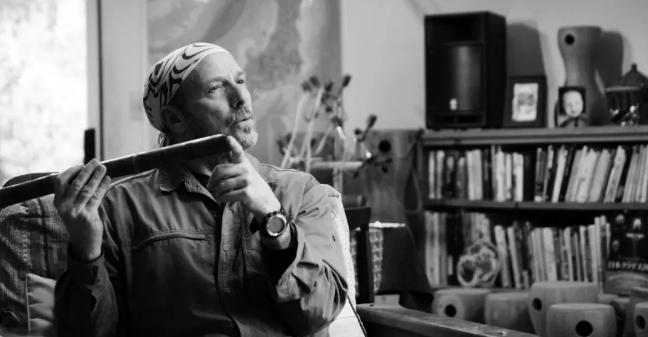Shakuhachi - A Global Journey of Ancient Musical Instruments
If one were to choose a piece of music that would give the anxious modern soul an outlet, it would be shakuhachi.
Shakuhachi, made of bamboo, is named after the length of the tube is one foot eight inches. The tone is desolate and deep, expressive, and can express the ethereal and quiet artistic conception.
The production of shakuhachi is exquisite, and the requirements for raw materials are extremely strict. Only a few bamboos that meet the specifications can be selected from a large bamboo forest. After 3-5 years, the production procedures such as grinding, painting and drilling can be started.
It is extremely difficult to get started with shakuhachi, and it is very difficult for beginners to play a harmonious voice.
It is precisely because of this difficulty that Shakuhachi is more attractive.
The shakuhachi has a variety of playing methods, rich timbres, and extremely rich expressiveness. Each player, after a long period of training and practice, will acquire their own sound.
Every shakuhachi player, playing, is the echo of the soul.
Too many people fall into their souls with one sound, and they will never be separated from it for a lifetime.
A thousand years ago, Shakuhachi was born in the prosperous Tang Dynasty, declined in the Song Dynasty, and gradually disappeared after the Yuan and Ming Dynasties.
However, during the Southern Song Dynasty, Japanese monks felt heartbroken outside the gate of the Renwang Zen Temple in Hangzhou, when they heard the layman Zhang Shen play shakuhachi. Later, he returned to Japan and founded the Japanese Buddhism Puhua Sect. Shakuhachi also entered the Japanese spiritual world and became the magic weapon of Puhua monks, and even for a long time, it was the weapon of the Japanese ronin.
In 2016, Helen heard Shakuhachi for the first time. A friend played a piece of music for her with a mobile phone and told her that it was an "ancient Chinese musical instrument". After studying Chinese painting and calligraphy for many years, she was a little confused: why had she never heard such a beautiful voice? Moved by this kind of music, she felt that she should do something for Shakuhachi. She decided to make a documentary for Shakuhachi.
"Shakuhachi · Yisheng I" was born from this. They spent a year photographing the lives of ten shakuhachi people. Among them are the relatively traditional shakuhachi performers such as Mitsuhashi Kifeng, the musician Haishan who brought shakuhachi from Japan to the United States, as well as the new generation of Chinese shakuhachi player Han Xuan and shakuhachi maker Fan Xingzhu—— Some of them are housewives, teaching their children to play shakuhachi at home, and some build wooden houses in the mountains to practice playing alone-in this documentary titled "Shakuhachi: A Sound of Life", they tell the trajectories of their lives, showing Various stories related to shakuhachi
Shakuhachi with the elegance and charm of the Tang and Song Dynasties has deeply impressed generation after generation. To this day, shakuhachi is no longer synonymous with "desolation" and "ancient".
Musician Yasuo Sato lives in temples all year round and plays shakuhachi music, but his more famous works are the theme song "Yi Ming" for "Onmyoji" and the theme song "Naruto Main Theme" for the anime "Naruto". He also joined the "Fuji Rock Festival" in an attempt to combine rock and shakuhachi.
Haishan, formerly known as John Neptune, is an American. He studied folk music at the University of Hawaii in his early years. In 1977, he obtained the qualification of the Shakuhatu mountain-style teacher. He has performed actively in Japan and around the world for many years. He is one of the most famous shakuhachi performers in the world. , regarded as one of the most skilled shakuhachi masters.

Haishan's timbre of shakuhachi is very different from the Japanese sound. Sometimes his timbre is vicissitudes of life, vigorous, sometimes high-pitched and bright, and sometimes cheerful and jumping. And created a new sense of shakuhachi with its unique modern style. In addition to Japanese traditional music, he is also good at playing jazz-style pieces with shakuhachi, and blends Indian, Indonesian and other world music styles into his music creation, and has collaborated with outstanding musicians from all over the world to record and perform.
Haishan has released a total of 23 albums so far, most of which are his own works. His works are rich in types, ranging from shakuhachi solos to multiples, as well as ensembles with various instruments such as the koto, and he has created a symphony of shakuhachi and koto, which he has performed with European symphony orchestras. His record Bamboo (Bamboo) won the Best Record of the Year Award from the Ministry of Education, Culture, Sports and Tourism of Japan.
Haishan is also a famous pipe maker, and his shakuhachi is very popular. Haishan is also an excellent percussionist. He has experimented with bamboo to make a variety of percussion instruments for many years. The popular CD "Bamboo Born" (Bamboo Born), most of the band's instruments are made by Haishan.
 渝公网安备 50010702504639号
渝公网安备 50010702504639号